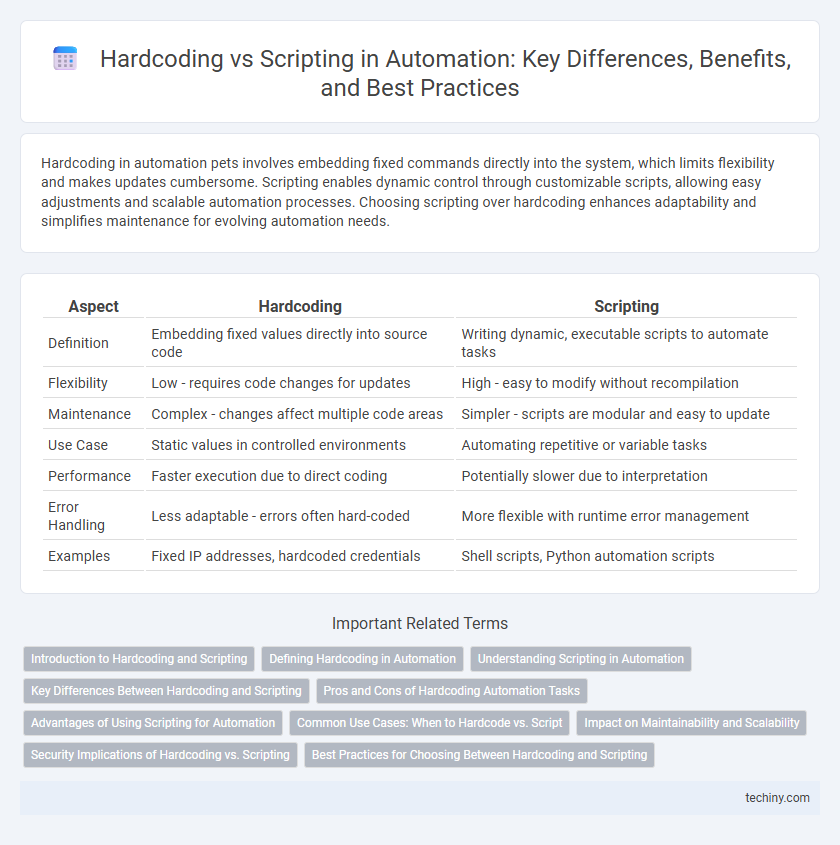Hardcoding in automation pets involves embedding fixed commands directly into the system, which limits flexibility and makes updates cumbersome. Scripting enables dynamic control through customizable scripts, allowing easy adjustments and scalable automation processes. Choosing scripting over hardcoding enhances adaptability and simplifies maintenance for evolving automation needs.
Table of Comparison
| Aspect | Hardcoding | Scripting |
|---|---|---|
| Definition | Embedding fixed values directly into source code | Writing dynamic, executable scripts to automate tasks |
| Flexibility | Low - requires code changes for updates | High - easy to modify without recompilation |
| Maintenance | Complex - changes affect multiple code areas | Simpler - scripts are modular and easy to update |
| Use Case | Static values in controlled environments | Automating repetitive or variable tasks |
| Performance | Faster execution due to direct coding | Potentially slower due to interpretation |
| Error Handling | Less adaptable - errors often hard-coded | More flexible with runtime error management |
| Examples | Fixed IP addresses, hardcoded credentials | Shell scripts, Python automation scripts |
Introduction to Hardcoding and Scripting
Hardcoding involves embedding fixed values directly into the source code, making the automation process rigid and less adaptable to change. Scripting utilizes flexible, often interpreted code to automate tasks, allowing easier modifications and reuse across different environments. Choosing between hardcoding and scripting affects scalability, maintainability, and efficiency in automated systems.
Defining Hardcoding in Automation
Hardcoding in automation refers to embedding fixed values directly into the code, making the process rigid and less adaptable to changes. This approach limits scalability and flexibility since any modification requires manual code updates. Hardcoding contrasts with scripting methods that utilize variables and external inputs to create dynamic, reusable automation workflows.
Understanding Scripting in Automation
Scripting in automation enables dynamic task execution through reusable and modifiable code snippets, enhancing flexibility compared to hardcoding. It allows automation processes to adapt to varying inputs and conditions, reducing manual intervention and improving efficiency. Common scripting languages such as Python, PowerShell, and Bash are widely employed to automate complex workflows and integrate diverse systems seamlessly.
Key Differences Between Hardcoding and Scripting
Hardcoding involves embedding fixed values directly into the source code, making the system rigid and difficult to modify, whereas scripting uses dynamic code that can be easily updated to automate tasks without altering the core program. Scripting languages like Python or Bash enhance flexibility and reusability, while hardcoded values often lead to increased maintenance overhead and limited scalability. The key difference lies in adaptability--scripting allows for parameter-driven automation, whereas hardcoding demands manual code changes for any updates.
Pros and Cons of Hardcoding Automation Tasks
Hardcoding automation tasks ensures high performance and reliability by embedding fixed values and commands directly into the code, reducing runtime errors and simplifying execution. However, it limits flexibility and scalability, as changes require code modifications and redeployment, making maintenance cumbersome in dynamic environments. This approach suits stable, repetitive tasks but struggles with adapting to varying inputs or evolving workflows.
Advantages of Using Scripting for Automation
Using scripting for automation offers significant advantages in flexibility and scalability compared to hardcoding. Scripts allow easy modifications and reuse across different tasks, enabling faster adaptation to changing workflows without extensive code rewrites. This approach also facilitates integration with various systems and tools, enhancing overall efficiency and maintainability in automated processes.
Common Use Cases: When to Hardcode vs. Script
Hardcoding is commonly used for fixed, unchanging values in automation tasks where stability and predictability are paramount, such as setting configuration parameters or embedding constants in code. Scripting excels in dynamic environments requiring flexibility, allowing automation of repetitive, conditional, or data-driven processes like batch file operations, system monitoring, and report generation. Choosing between hardcoding and scripting depends on the need for adaptability versus the simplicity of static code, with scripting favored for scalability and hardcoding preferred in controlled, inflexible contexts.
Impact on Maintainability and Scalability
Hardcoding reduces maintainability by embedding fixed values directly into code, making updates time-consuming and error-prone, whereas scripting enhances flexibility by allowing dynamic adjustments through external scripts or parameters. Scripting supports scalability by enabling modular code reuse and easier integration with automation frameworks, while hardcoded solutions often require extensive rewrites as system complexity grows. Automating tasks via scripts significantly improves long-term adaptability and streamlines scaling processes compared to rigid hardcoded implementations.
Security Implications of Hardcoding vs. Scripting
Hardcoding sensitive information such as passwords or API keys directly into automation scripts presents significant security risks, including unauthorized access and difficulties in updating credentials. Scripting with external configuration files or environment variables enhances security by enabling centralized management and reducing exposure in the codebase. Proper secrets management practices, including using vaults or encrypted storage, further mitigate vulnerabilities associated with hardcoded data in automation workflows.
Best Practices for Choosing Between Hardcoding and Scripting
Choosing between hardcoding and scripting depends on flexibility, maintainability, and scalability requirements. Hardcoding offers simplicity and speed for static, unchanging tasks, while scripting supports dynamic automation and easier updates through parameterization and code reuse. Best practices emphasize using scripting for complex, repetitive processes to enhance adaptability and avoiding hardcoding to reduce technical debt and improve long-term project sustainability.
Hardcoding vs Scripting Infographic

 techiny.com
techiny.com